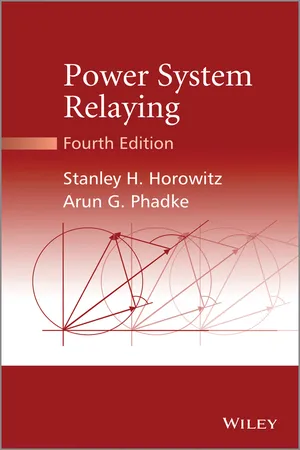![]()
Chapter 1
Introduction to Protective Relaying
1.1 What is Relaying?
In order to understand the function of protective relaying systems, one must be familiar with the nature and the modes of operation of an electric power system. Electric energy is one of the fundamental resources of modern industrial society. Electric power is available to the user instantly, at the correct voltage and frequency, and exactly in the amount that is needed. This remarkable performance is achieved through careful planning, design, installation, and operation of a very complex network of generators, transformers, and transmission and distribution lines. To the user of electricity, the power system appears to be in a steady state: imperturbable, constant, and infinite in capacity. Yet, the power system is subject to constant disturbances created by random load changes, by faults created by natural causes, and sometimes as a result of equipment or operator failure. In spite of these constant perturbations, the power system maintains its quasi-steady state because of two basic factors: the large size of the power system in relation to the size of individual loads or generators and correct and quick remedial action taken by the protective relaying equipment.
Relaying is the branch of electric power engineering concerned with the principles of design and operation of equipment (called “relays” or “protective relays”) that detects abnormal power system conditions and initiates corrective action as quickly as possible in order to return the power system to its normal state. The quickness of response is an essential element of protective relaying systems—response times of the order of a few milliseconds are often required. Consequently, human intervention in the protection system operation is not possible. The response must be automatic, quick, and should cause a minimum amount of disruption to the power system. As the principles of protective relaying are developed in this book, the reader will perceive that the entire subject is governed by these general requirements: correct diagnosis of trouble, quickness of response, and minimum disturbance to the power system. To accomplish these goals, we must examine all possible types of fault or abnormal conditions that may occur in the power system. We must analyze the required response to each of these events and design protective equipment that will provide such a response. We must further examine the possibility that protective relaying equipment itself may fail to operate correctly, and provide for a backup protective function. It should be clear that extensive and sophisticated equipment is needed to accomplish these tasks.
1.2 Power System Structural Considerations
1.2.1 Multilayered Structure of Power Systems
A power system is made up of interconnected equipment that can be said to belong to one of the three layers from the point of view of the functions performed. This is illustrated in Figure 1.1.
At the basic level is the power apparatus that generates, transforms, and distributes the electric power to the loads. Next, there is the layer of control equipment. This equipment helps to maintain the power system at its normal voltage and frequency, generates sufficient power to meet the load, and maintains optimum economy and security in the interconnected network. The control equipment is organized in a hierarchy of its own, consisting of local and central control functions. Finally, there is the protection equipment layer. The response time of protection functions is generally faster than that of the control functions. Protection acts to open- and closed-circuit breakers (CBs), thus changing the structure of the power system, whereas the control functions act continuously to adjust system variables, such as the voltages, currents, and power flow on the network. Oftentimes, the distinction between a control function and a protection function becomes blurred. This is becoming even more of a problem with the recent advent of computer-based protection systems in substations. For our purposes, we may arbitrarily define all functions that lead to operation of power switches or CBs to be the tasks of protective relays, while all actions that change the operating state (voltages, currents, and power flows) of the power system without changing its structure to be the domain of control functions.
1.2.2 Neutral Grounding of Power Systems
Neutrals of power transformers and generators can be grounded in a variety of ways, depending upon the needs of the affected portion of the power system. As grounding practices affect fault current levels, they have a direct bearing upon relay system designs. In this section, we examine the types of grounding system in use in modern power systems and the reasons for each of the grounding choices. Influence of grounding practices on relay system design will be considered at appropriate places throughout the remainder of this book.
It is obvious that there is no ground fault current in a truly ungrounded system. This is the main reason for operating the power system ungrounded. As the vast majority of faults on a power system are ground faults, service inter...

